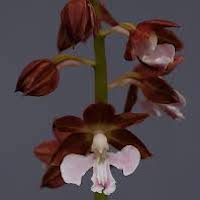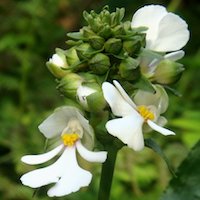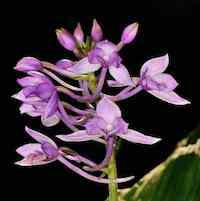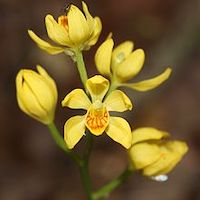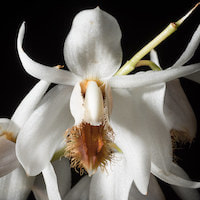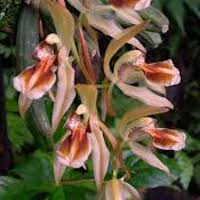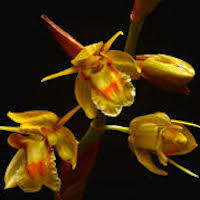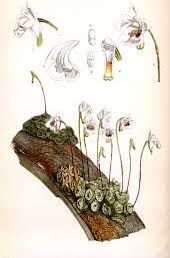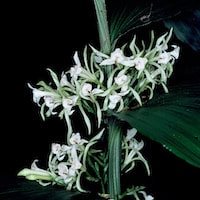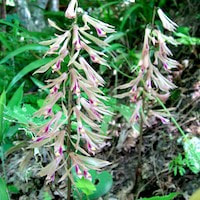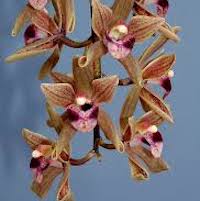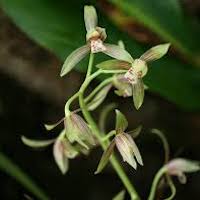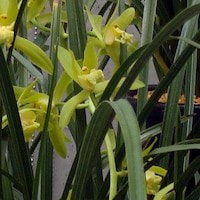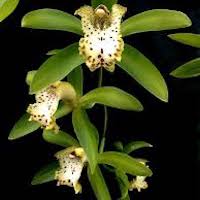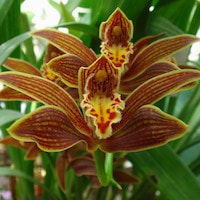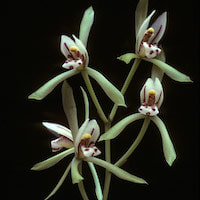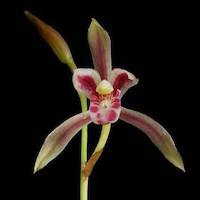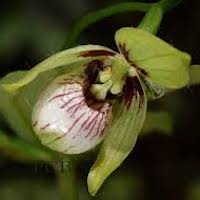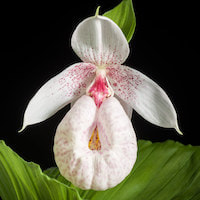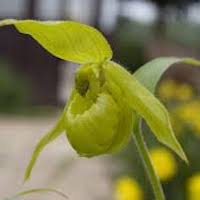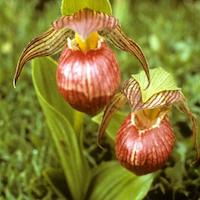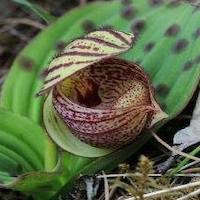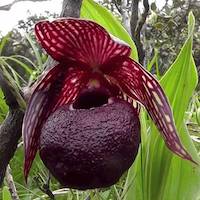|
Genus: Calanthe Brown
Calanthe, commonly called Christmas orchids, is a genus of about 220 species. Chinese name: Xiaji Lan (prawn spine orchid) Japanese name: Ebine They are terrestrial plants with thick roots, small oval pseudobulbs and large corrugated leaves. The sepals and petals are narrow and a similar size to each other and the labellum usually has spreading lobes. Calanthe are sympodial orchids with short stems and several plicate, elliptical leaves that are spirally arranged, or arranged in two rows, ensheathing the stem. Inflorescences arise at the side or from the base and carry many showy flowers on a short raceme. Calanthe is the first orchid species to be artifi- cially hybridised by man. Calanthe, was derived from two Greek words, kalos (beautiful) and anthe (bloom), meaning ‘beautiful flower’. |
|
Calanthe alismifolia Lindl. and Calanthe nigropuncticulata Fukuyama
Chinese names: Zexiexiaji Lan, Xidiangenjie Lan Taiwan: black- spotted Calanthe; white flower Calanthe Chinese medicinal name: Zongyeqi Plants are harvested in summer and autumn, washed clean and sun-dried for future use. For consumption, decoction is made with 6–12 g of the whole dried plant. The herb is acrid, bitter and considered cool in nature. In Traditional Chinese Medicine the whole plant is considered antipyretic. It is believed to detoxify, remove gas, reduce stasis of blood and reduce swellings. It also improves blood circulation, and heals ulcers and traumatic injuries. |
|
Calanthe alpina Hook Syn. Calanthe fimbriata Franch.
Chinese name: Liusuxiaji Lan (tassels prawn spine orchid) Medicinal names: Mayaqi (horse teeth seven). The name is same as Calanthe davidii; Jiuxilian (nine son lotus), Daxiancao (large divine herb) Herbal Usage: It is prescribed for stomach ulcer, acute distension of the stomach, hepatitis, scrofula, toothache, sore throat, common colds, painful joints, fatigue, snake bite, and traumatic and chest injuries. Roots and stem are used to remove “heat” and toxins, relieve pain, and dispel “wind” or to hasten the disappearance of ecchymosis. It can be used in three ways- 1- in decoction, using 15–30 g fresh herb 2- in decoction, treat chronic pharyngitis, 30 g together with Ba zhao long 60 g 3- as a paste for external application, just grinding a suitable amount of Mayaqi The herb is collected in summer from Hebei, Shanxi, Hunan, Hubei, Guizhou, Yunnan and Sichuan. |
|
Calanthe brevicornu Lindl. Syn. Calanthe lamellosa Rolfe
Chinese name: Shenchunxiaji Lan (kidney lips prawn spine orchid) Herbal Usage: CHM employs the root to counter ‘heat’, promote diuresis, arrest bleeding, reduce swelling, and to treat nephritis or the presence of blood in the urine. It is usedused to promote expul- sion of an incompletely delivered placenta, recov- ery after a stillbirth, or to stop abdominal pain caused by ‘poor air’ It flowers from May to June. It is distributed from northeast India, Bhutan and Nepal to Xizang, Yunnan, Sichuan, Hubei and Guangxi in China. Flowers smell like cinnamon. |
|
Calanthe davidii Franch.
Chinese name: Jianyexiaji Lan (sword leaf prawn spine orchid) Changyegenjie Lan Chinese medicinal name: Mayaqi (the name is shared with Calanthe alpina) Description: Flowers are numerous, crowded, randomly orientated. It is distributed from India across southern China to Taiwan and southern Japan. It is probably seriously endangered or extinct in the Himalayas now. Herbal Usage: Herb (Mayaqi) refers to both C. alpina and C. davidii. They are used in range of Chinese Herbal Medicine . |
|
Calanthe densiflora Lindl.
Chinese name: Zhuyegenjie Lan (bamboo leaf segmented root orchid), Mihuaxiaji Lan (prawn spine flower orchid) It is a terrestrial herb found in shaded hardwood forests of southern Himalayas, China, Indochina and Japan. In Taiwan, it is found below 1500 m throughout the island. It is the last Calanthe to flower in Taiwan, flowering from October to December. Herbal Usage: Taiwanese Chinese Herbal uses whole plant to improve blood circulation, and reduce stasis of blood and swellings. It is also used to remove gas and humidity and to treat rheumatism, backache, pain affecting the lower limbs, running sores and traumatic injuries. |
|
Calanthe discolor Lindl.
Chinese names: Xiaji Lan (prawn spine orchid) Chinese medicinal names: Jiuzilianhuancao (nine united sons flowering herb)—this name also refers to Calanthe tricarinata; zhu chuan zhu (string of beads); ye baiji (night white chicken); Roulainhuan (meat in circles); Jiujiechong (nine segment bug); Yichuanniuzi (string of buttons). Phytochemistry: 4 compounds found in this orchid improve blood flow through the skin and promoted hair growth. These are - calanthoside (indole, S,O-bisdesmoside), glucoindican, calaliukiueno-side, calaphenanthrenol. It also has tryptanthrin, indirubin, isatin and indicant. Herbal Usage: Herb is obtained from Huadong (in Guangdong Province). It is used to dissolve extravasated blood and improve circulation. Entire plant, roots and stem are used to improve blood flow, and to heal abscesses, scrofula, rheumatism, bone pain and traumatic injuries. It is also used to treat skin ulcers and haemorrhoids. |
|
Calanthe graciliflora Hayata Syn. Calanthe hamata Hand. Mazz
Chinese names: Goujuxiaji Lan (splayed hooks prawn spine orchid), Xiyegenjie Lan (fine leaved, segmented root orchid), Xihuagenjie Lan (fine flowered, segmented root orchid), Zhihuagenjie Lan (brocade flower segmented root orchid), Goujuxiaji Lan (hooked prawn spine orchid) in Taiwan: slender flower Calanthe Chinese medicinal name: Silima Herbal Usage: In Taiwan, the entire plant is used to relieve fever and for detoxification. It boosts yin elements, benefits the lungs, improves blood flow, reduces stasis of blood, detumescence, and stops pain and coughing. On the mainland, the entire plant is used to treat rheumatism, bone pain, traumatic injuries. |
|
Calanthe masuca (D. Don) Lindl. Syn. Calanthe sylvatica (Thou.) Lindl.
Chinese names: Changjuxiaji Lan (long spur prawn spine orchid), Zihuaxiaji Lan (purple flower prawn spine orchid), Shankala, Shanzhizhu (mountain spider) Myanmar Name: Thazin gyi myo kywe Nepali Name: Pakha phul Description: This was the parents of the first hybrid orchid to be bred by man. This is a highly variable. Plants from the Chinese mainland are larger. Nepalese plants have flowers of deep violet. Flowers in Bhutan are violet to purple. Herbal Usage: Herb is obtained from Fujian, Jiangxi, Yunnan, Hunan, Guangxi, Guangdong and Xizang. The entire plant is used as an ano- dyne. It also reduces swellings, removes toxins and repairs wounded tissues, removing abscesses. In Nepal, a paste made from the stem is applied to treat dislocated bones. The flowers are used to arrest epistaxis, Pseudobulbs are also used to treat nose bleeds . |
|
Calanthe puberula Lindl. Syn. Calanthe similis Schltr.
Chinese names: Lianexiaji Lan (sickle lip orchid), Fanjuangenjie Lan (counter folding root segment orchid), Juanegenjie Lan (fold- ing calyx root segment orchid), Lianyexiaji Lan (sickle leaf prawn spine orchid): Jiaxiaji Lan (fake prawn spine orchid), Xiangsixiaji Lan (similar prawn spine orchid) Zigenjie Lan (purple root orchid) Chinese medicinal name: Lianexiaji Lan (sickle lip orchid) Herbal Usage: Herb is obtained from Yunnan, Guangxi and Guandong. The whole plant is used in Chinese Herbal Medicine to treat scrofula, and sores that itch. It is antipyretic and detoxifies. Used for running sores, it improves blood flow and stops pain. It is used to treat ulcers, scrofula, mange, scarlet fever, amenorrhoea, trauma and dysentery in Taiwan. |
|
Calanthe tricarinata Lindl.
Chinese name: Sanlengxiaji Lan (triangular prism prawn spine orchid) Chinese medicinal name: Jiuzilianhuancao (nine united sons flowering herb) This name also refers to Calanthe discolor; Roulianhuan Herbal Usage: It is found in Shanxi, Hubei, Sichuan, Yunnan, Guangxi, Guizhou and Xizang. Leaf paste is used to treat wounds and eczema in Nepal. In that country, leaves and pseudobulbs are valued as aphrodisiacs. In Uttarakhand, West Himalaya, roots and leaves are used to treat jaundice and typhoid. In China, the root is used to stimulate blood circulation, relax muscles and joints, remove wind and stop bleeding. It is used in the treatment of stomachache, arthritis, lumbar muscle degeneration and traumatic injuries. |
|
Calanthe triplicata syn. Calanthe veratrifolia R. Br. ex Ker Gawl.
Chinese names: Sanzhexiaji Lan (three layered shrimp’s spine), Baihe Lan (white crane orchid), Shishangjiao (leaf on the stone), Roulianhuan (meaty chain of rings); Paiwan (put in order and bend in a stream), embossed banana leaf orchid Chinese medicinal name: Shishangjiao (leaf on the stone) Japanese name: Tsuru Ran Thai name: Ueang Kao Tog Indonesian names: Lau Bawang in Kalimantan Barat; Angkrek Popotjongan, Ahan Malona (Amboin); Bunga Tiga Lapis (Maluku); Guru ni Hambing (Batak Toba) Lumbu Hutan (Sumatra and Timor); Seugeundeu (Gajo Singkut in Batak Karo) Anggrek bayi tidur (Sulawesi) Phytochemistry: Leaves of C. triplicata produce indigo when bruised. Herbal Usage: In Taiwan use the root to treat rheumatism, backache and traumatic injuries including fractures. The whole plant is a diuretic. In Karnataka the roots are used for diarrhoea and toothache. In Arunachal Pradesh, the roots are an ingredient in a remedy for swollen hands, and, in a separate combination, used for treating diarrhea. Various parts of the plant are used to treat toothache. Pseudobulbs are a masticatory for a variety of gastrointestinal disorders while flowers are used to relieve toothache. Root extract is used to treat diarrhoea and toothache. Rumphius from 17th century Amboin (Sulawesi) noted that the plant was “quite sharp” and cautioned regarding its use. He said that, the taste of the roots is insipid, but suddenly it becomes quite sharp, “like some Gentiana, burning the mouth, so that one’s lips will swell, one’s throat gets hoarse, and one even feels this sharpness in the leaves, wherein it differs from all Angreks”. Back then, the roots were used together with nutmeg, cloves and two types of ginger “rubbed together and tied to” the swollen hands |
|
Calanthe vestita Wall ex Lindl.
Thai name: Khao Malila Myanmar name: Thazin gyi ahphyu Herbal Usage: It reduces stasis of blood, improves blood circulation and detoxifies. In Chinese herbal medicine, it is used for swellings of different kinds- aetiology, abscess, trauma, arthritis, and painful joints. Wine fortified by the roots of some Calanthe species was reportedly used in China to treat traumatic injuries and internal bleeding. In Southeast Asia is used in Vietnam to treat rheumatism. Ayervedic use it to treat rheumatism, backache and trauma. In Amboin, the root of C. triplicata is a component of a remedy for swollen hands. In Sumatra, its flowers are used to relieve pain from dental caries. Phytochemistry: Leaves of C. vestita contain flavone C-glycosides. Herbal Usage: In Vietnam, crushed bulbs are rubbed over aching bones of people suffering from rheumatism. Six bacterial strains belonging to the genera Athrobacter, Bacillus, Mycobacterium and Pseudomonas have been isolated from the roots. Calanthe has two great benefits 1- a hair-restoring property, and 2- a possible anticancer agent. Calanthoside, glucoindican, calaliukiuenoside and calaphenanthrenol present improved blood flow through the skin and promoted hair growth. Calanquinone A from C. arisanensis exhibited potent antitumour activity against lung (A549), prostate (PC-3 and DU145), colon (HCT-8), breast (MCF7), nasopharyngeal (KB) and vincristine-resistant nasopharyngeal (KB-VIN) cancer cell lines. Calanquinone A induces s-phase arrest and apo- ptosis of glioblastoma (brain tumour) cell types A172, T98 and U87 by decreasing cellular glutathione. It also contains other calanquinones (B and C). Four new 9,10- dihydrophenanthrenes, calanhydroquinones A, B, C and calanphenanthrene A, and several other known compounds |
|
Callostylis bambusifolia (Lindl.) S.C. Chen & J.J. Wood Syn. Eria bambusifolia Lindl.
Indian name: Mundabai The species is distributed from Vietnam, Thailand, Myanmar and southern Yunnan to northeast India down to Orissa state. Herbal Usage: The entire plant is used to treat stomach upsets in India (Dongria Kandha hill tribe). A plant of Callostylis bambusifolia (syn. Eria bambusifolia) and another of Aegle marmelos (not an orchid) are separately burnt to ashes in earthen pots, and thereafter their ash is mixed in a 1:1 ratio. Half a tablespoon is administered on an empty stomach twice a day for one week to treat hyperacidity and stomach upsets. |
|
Cephalanthera erecta (Thunb.) Blume
Chinese name: Yin Lan (silver orchid) Chinese medicinal name: Yin Lan (silver orchid) It is native to the Eastern Himalaya, China and Japan, growing amidst grasses and low shrubbery. Herbal Usage: Herb is obtained from Shanxi, Hubei, Zhejiang, Jiangxi, Guangdong and Sichuan. Plant is used to treat fever, thirst, urinary infection. It is diuretic. |
|
Cephalanthera falcata Lindl.
Chinese names: Jin Lan (gold orchid), Lianyetourui Lan (pistal above sickle leaf orchid) Chinese medicinal name: Jin Lan (gold orchid) Herbal Usage: Herb is obtained from Hubei, Hunan, Guangdong, Guangxi, Yunnan and Sichuan. The entire plant is anti heat, and relieves fever. It is used to treat sore throat and toothache. |
|
Cephalanthera longifolia (L.) Fritsch.
Chinese names: Changyetourui Lan (pistal above the long leaf orchid), Tourui Lan Phytochemistry: Alkaloids, quercetin and kaempferol-O-glycosides are present in C. longifolia. Loroglossin is present in this Orchid. Herbal Usage: Roots and stems are used for nocturesis and enuresis in TCM. In Arunachal Pradesh, roots and rhizomes are valued as tonic. Antibiotics might be present in the mixotrophic C. falcata which is used to treat toothache and sore throat. It is on the red list of endangered orchid species. |
|
Changnienia amoena Chien
Chinese names: Duhua Lan (solitary flower orchid) Chinese medicinal name: Changnian Lan Herb is obtained from Zhejiang, Jiangsu, Hunan and Sichuan Herbal Usage: To treat bloody phlegm, a decoction is prepared with 15–30 g of dried or 60–90 g of fresh herb, then sweetened with white sugar and drunk day and night before meals. To treat sores, a poultice is made by mixing fresh pulverised plant with salt. The whole plant together with its roots is regarded as antiheat and antitoxic. It cools the blood. It is used in the treatment of coughs, blood-streaked sputum, sores and furuncles. |
|
Cleisostoma fuerstenbergianum Kraenzl Syn. Cleisostoma flagelliforme (Rolfe ex Downie) Garay
Chinese name: Changyegeju Lan (long leaf separate distance orchid) Thai names: Kloi nam thai in Ubon Ratchathani; kang pla Herbal Usage: Herb is obtained from Hainan and Yunnan. The whole plant is used as a remedy for heat and toxins, sore throat and tonsillitis in China. Leaves are used to treat diabetes in Thailand. |
|
Cleisostoma paniculatum (Ker-Gawl) Garay
Local names: big centipede orchid; tiger stripes; Taiwan centipede; purple stripes The species is distributed from Taiwan southwards to Fujian, Hong Kong, Vietnam, north- eastern and central Thailand and northeast India Herbal Usage: The entire plant is used to boost yin, treat coughs and to strengthen the lungs in Taiwan. |
|
Cleisostoma tenuifolium (L.) Garay
Common name: delicate leafed Cleisostoma Old Malabarese name: Mau Tsjerou Maravara, Ambo keli; Kolli Tsjerou Mava-maravara, Abo-tia Herbal Usage: It is used in western peninsular India to treat kidney disorders, leucorrhoea, gonorrhoea and scalds. Made into a poultice, Kolli Tsjerou Mava- maravara was used to reduce pain and swelling of abscesses and to promote their rupture. Plant was also blended in vinegar and administered to expel kidney stones, treat dysuria, gonorrhoea, other forms of white vaginal discharge and heavy menstrual loss. |
|
Cleisostoma williamsonii (Reichb. f.) Garay Syn. Cleisostoma hongkongense (Rolfe) Garay
Common Name: Dianmiangeju Lan (Yunnan - Myanmar separate distance orchid) Chinese medicinal name: Longjiaocao Taste is mildly sweet and sour, and it is neutral in nature. It is mildly sweet and sour in flavour, neutral in nature. Herbal Usage: The Chinese herb is obtained from Guangdong, Guangxi and Yunnan throught out the year. It is sometimes dried for future usage. Plants can be harvested throughout the year. They are washed and sun-dried. The whole plant is used to improve blood circulation, relax muscles and joints, clear phlegm and stop coughs. It is used in treating pulmonary tuberculosis, viral encephalitis, stroke, polio, backache and indigestion in children. It simulates circulation, relaxes muscles and joints, stops coughing and is an expectorant. A Guangxi Materia Medica mentioned that it was used during epidemics of encephalitis B and to treat patients with tuberculosis or paralysis resulting from stroke or poliomyelitis, and malnourished children. |
|
Coelogyne barbata Lindl. ex Griff.
Chinease name: Xuchunbeimu Lan (beard and lip pearl shell orchid), Ranmaobeimu Lan Chinese medicinal name: Fengian 1- Decoction, use 15–30 g of plant. It is used for cough (lung heat), sore throats, Pain associated with hernia or scrotal swelling. 2- For external use: an appropriate amount, pulverise and apply. The paste is used on Bruises and Sprains, Chapped hands and feet. |
|
Coelogyne corymbosa Lindl. syn Pleione corymbosa (Lindl) Kuntze
Chinese name: Yanbanbeimu Lan (eye spotted pearl shell orchid), Beimu Lan (pearl shell orchid), Zhixueguo (haemostatic fruit); Shibajiao (stone palm leaves); Duiyeguo (fruit with a pair of leaves); Xiaoluji (small green Chinese elder) Chinese medicinal name: Beimu Lan (pearl shell orchid); Guoshangye (leaves above the fruit) Newari name: Tuyu kenbu swan Herbal Usage: Herb is obtained from Yunnan and Xizang. It may be collected at any time of the year. Pseudobulbs or entire plant are used to treat fractures and soft tissue injuries. The herb is used as a haemostatic and to relieve pain. It reduces heat, stops coughs, and is taken for coughs, flu and bronchitis. Four common prescriptions are:
|
|
Coelogyne cristata Lindl. Coelogyne speciosissmum D. Don
Chinese name: Beimu Lan (pearl shell orchid). Note that this name does not distinguish it from the preceding species. Indian name: Hadjojen (bone joiner) Nepali names: ban maiser, jhyanpate in Chepang dialect; chandi gabha (Nepali), syabal (Tamang) Distributed throughout Nepal, Bhutan and north- ern India, Bangladesh, Tibet and Myanmar. Phytochemistry: Ethanolic extract of cristata is strongly bacteriostatic against Staphylococcus aureus and moderately against Escherichia coli . Coelogin and coeloginin, and two novel 9,10-dihydrophenanthrene derivatives, coeloginanthridin and coeloginanthrin, were isolated from air-dried, finely-ground whole plant. 4 compounds possess the biological activities of phytoalexins and endogenous plant growth regulators. Modern research support the notion that the folk tradition of using C. cristata to treat fractured bones in the Kumaon region of Uttarakhand may have a rational basis. Herbal Usage: Hadjogen (means bone joiner) is used in the Himalaya to treat fractured bones in animals. It is used to treat dysentery and diarrhoea in Myanmar. In Nepal an infusion of pseudobulbs is used to correct constipation. Nepalese also use this orchid as an aphrodisiac. Juice squeezed from the pseudobulbs is applied to boils and to wounds on the hooves of animals. |
|
Coelogyne flaccida Lindl.
Chinese names: Lilinbeimu Lan (chestnut scales pearl shell orchid), Guishangye (the leaf above fruits) Chinese medicinal name: Jidatui Nepali name: Thur gava Phytochemistry: Phenanthrenes and stilbenoids have been isolated from this orchids - flaccidin, soflaccidin and isooxoflaccidin. Herbal Usage: Herb collected from Guizhou and Yunnan is a popular medicine among the minority tribes in both provinces. In China, the whole plant is used to clear heat, counter dryness, promote the production of body fluids, and to clear phlegm and stop coughs. Pseudobulbs are made into a paste in Nepal and applied to the forehead to treat headache, while the juice treats indigestion. |
|
Coelogyne fuscescens Lindl.
Chinese name: Hechunbeimu Lan Thai names: Sing to, phaya rat, phao hin Herbal Usage: The whole plant is considered aphrodisiac in Thailand.Stems are also used to treat burns and otitis media. In Nepal, abdominal pain is treated with juice extracted from pseudobulbs or a poultice made with it. |
|
Coelogyne leucantha W.W. Sm.
Chinese name: Baihuabeimu Lan (white flower pearl shell orchid) Herbal Usage: Herb is obtained from Yunnan. Pseudobulbs and sometimes the entire plant is used to lessen heat, stop coughs, improve blood flow, reduce pain, promote the union of fractured bones and repair torn tendons. |
|
Coelogyne nitida (Wall ex D. Don) Lindl. Syn. Coelogyne ochracea Lindl.
Chinese name: Mijingbeimu Lan Nepali names: Silver Orchid in English, bhyanpat (Chepang), Salida, Sanit (Gurung), Chandi gabha, para phul (Nepali) Phytochemistry: Ochrolide, a phenanthropyrone, and Ochrone A, 9.10-dihydro-1,4-phenanthraquinone together with coelonin are present in this orchid. Also a ochrolic, a monomeric phenanthrene derivative and a precursor to phenanthropyrones, was isolated. Herbal Usage: Juice of the pseudobulb is recommended for stomach ache in Nepal. |
|
Coelogyne occultata Hook. f. syn Pleione occulta (Hook f.) Kuntze
Chinese name: Luanyebeimu Lan (ovate leaf pearl shell orchid) Chinese medicinal names: Luanyebeimu Lan (ovate leaf pearl shell orchid); Youguashihu (squashed epiphyte) Usage: Herb is obtained from Yunnan and Xizang. It nourishes yin, protects the kidney, nourishes the stomach and promotes the production of body fluids. Plant is used to treat hot flushes, fever, nocturnal emission, backache, anorexia and gastritis. |
|
Coelogyne ovalis Lindl.
Chinese name: Changlinbeimu Lan Indian name: Jeevanti Phytochemistry: Lot of molecules are present, namely- 2,7-dihydroxy-3,4,6- trimethoxy-9,10-dihydrophenanthrene, coelogin, coeloginin, flavidin, flavidinin, batatasin III, imbricatin, beta-sitosterol and its glycoside and a new bibenzyl compound, 30-o-methylbatatasin III. Flavidin and coelogin showed spasmolytic activity. Flavidin produced 50% and 90% inhibition of barium chloride-induced spasm of the guinea pig. Herbal Usage: It is known as Jeevanti which means ‘promoting life’, and in this respect it is used as a tonic. In Nepal, pseudobulbs are regarded as aphrodisiacs, hence the name Jeevanti. It is also used in western and southern India to treat coughs, urine infections and eye disorders. |
|
Coelogyne prolifera Lindl. Syn. Coelogyne flavida Hook. f.
Chinese name: Huanglubeimu Lan Nepali names: Liso in Gurong dialect, Thurgaujo (Nepali) Phytochemistry: Flavidin, 9,10- dihydrophenanthrene derivative, has been isolated. Four related compounds, flavidinin and oxoflavidinin a 9,10-dihydrophenanthropyran named flaccidin and imbricatin are also present in the orchid. Herbal Usage: Paste made with pseudobulbs of C. prolifera is rubbed on the back to relieve backache and to treat boils in Nepal. |
|
Coelogyne stricta (D. Don) Schltr. Syn Coelogyne elata Lindl.
Indian name: Harjojan Phytochemistry: A 9,10- dihydrophenanthropyrone and a 9,10- dihydrophenanthrene named coelonin was obtained from this orchid. The phytoalexins exhibit bacterostatic and fungistatic activities. Usage: In northeast India, it is used to promote healing of bones and is applied externally to fractured limbs. Poultice made with pseudobulbs is applied to relieve headache and fever in Nepal . |
|
Coelogyne trinervis Lindl.
Thai name: Ueang mak It is sacred in some parts of Indonesian Borneo (Kalimantan) and here it was believed that the abundance of the rice harvest could be predicted by seasonal profusion of its flowers. Herbal Usage: In Thailand, the tuber is used to treat fractures and sprains. It is used to treat dysentery and diarrhoea in Myanmar whereas infusion of its pseudobulbs is used to treat constipation or indigestion in Nepal. This suggests that the pseudobulbs of the orchid may contain heat-labile and heat-stable compounds with opposing actions, as is the well-known case with Angelica sinensis. C. cristata contains coelogin (a 9,10-dihydrophenanthrene derivative) which has been shown to reduce intestinal spasms. The observation supports the Burmese herbal usage of the orchid. C. cristata is sometimes used to treat headache and fever in Nepal. Three species of Coelogyne are regarded as aphrodisiacs. Uniflorin, a steroidal ester, 4 phenanthrene derivatives, coelogin, coeloginin, coeloginanthridin and coeloginanthrin were extracted from this plant. The last four compounds possess the biological activities of phytoalexins and endogenous plant growth regulators. |
|
Conchidium muscicola (Lindl.) Rausch.Syn. Eria muscicola (Lindl.) Lindl.
Sanskrit Name: Jivanti Herbal Usage: The Sanskrit word Jiva means ‘life’ and the term Jivanti is used for many herbs which are considered to be powerful tonics possessing rejuvenating and life- prolonging properties. They also act as aphrodisiacs. The pseudobulbs are used in India to treat diseases of the heart and lungs, disorders of the nervous system, eye, ear and skin, facial tumours, fever and rabies. Usage in Nepal is fairly similar: it is used to treat heart, lungs and psychiatric disorders. |
|
Corymborkis veratrifolia (Reinw.) Blume
Chinese name: Guanhua Lan Malaysian name: Kayu Hok in aboriginal Semang Phytochemistry: Alkaloid is present in Corymborkhis veratrifolia. Herbal Usage: In India, juice freshly extracted from the leaves is used as an emetic. It is used to treat cuts on the feet in the British Solomon Islands. |
|
Cremastra appendiculata (D. Don) Makino Syn. Crematra variabilis (Blume) Nakai; Cym- bidium wallichiana Lindl.
Chinese name: Mabian Lan (horse whip orchid), Dujuan Lan (Azalea orchid); Shancigu (kind mountain lady), Maocigu (kind furry lady), Sandangu (three layer hoop) Japanese: Sai-hai ran (purple orchid standard), Sanjiko Korean: Sanjago, Yaknancho Medicinal names: The Chinese Shancigu also refers to Pleione bulbocoides. It is Sanjiko in Japanese, and Sanjago in Korean. Their similarity denotes an ancient common origin. Phytochemistry: It has 5,7-dihydroxy-3-(3-hydroxy- 4-methioxybenzyl)-6-methoxychroman-4-one is the homoisoflavanone that inhibits basic fibroblast growth factor. It also inhibits inflammatory and allergic response in mast cells, and ultraviolet beam-induced skin inflammation by reducing cyclooxidagenase-2-expression and NF-kappa B nuclear localization. Tyrosine is the enzyme that promotes melanin formation, darkening of skin and UV protection. Scientists isolated several compounds , some of which can be used in cancer treatment. Herbal Usage: It was first listed as a medicinal herb in Chen Can Qi’s Ben Cao Shi Yi (Omissions from the Medica Medica) compiled around 720 AD, during the Tang Dynasty. Stem was used to treat impotence, tuberculosis, fever, frostbite, snake bites and poisoning in general. It was also used to treat abscesses and swellings. Paste made with the pseudobulb was spread over a boil to heal it. In Japan, the Ainu chew on a pseudobulb of C. appendiculata to relieve a toothache. They also use it to treat snake bites and insect bites |
|
Crepidium acuminatum (D. Don.) Szlach. Syn. Malaxis acuminata D. Don., Microstylis wallichii Lindl.
Indian names: Jeevak in Hindi, Jivak (Tamil), Jivakam (Malayalam), Jivakam (Tekugu, Jivakamu (Kannada), Jivaka (Sankrit): Lahsunia (vernacular name in Kumaun Himalaya) Ayurvedic names: Jivak, Rishvak, Rishbhaka, Bandhura, Dhira, Durdhara, Gopati, Indraksa, Kakuda, Matrika, Visani, Vrisa, Vrisnabha Pseudobulbs are used to treat bleeding disorders, fever, tuberculosis and a sensation of heat, emaci- ation, dysentery, rheumatism and insect bites. It is incorporated into the Ayervedic tonic “Chyavanprash”, a popular herbal preparation for promoting health and preventing illness . Jeevak or Jivak (C. acuminatum) features in the following formulations: Astavargha churna, Chyanprash rasayan, Chitrakadi taila, Vachadi taila, Mahakalyan ghrita, Mahamayura ghrita, Mahapadma taila, JIvaniya ghrita, Vajkaran ghrita, Brahini gutika and Himvana agada. Malaxis cylindrostachya (Lindl.) Kuntze and Malaxis mackinnoni (Duthie) Ames are some- times used when C. acuminatum is not available. Other substitutes are Pueraria tuberosa (Vidara kand), Centaurea behen (Safed behmen), Centaurium roxburghii (D. Don) Druce (or Lal behmen) and Tinospora cordifolia (Guruchi). |
|
Crepidium resupinatum (G. Forst.) Szlach. Syn. Seidenfia rheedii (Sw.) Szlach. (see Liparis rheedii Sw.); Seidenfia versicolor Marg. & Szlach.
Phytochemistry: Pseudobulb of C. acuminatum contains an alkaloid, glycosides, flavonoids, beta sitosterol, piperitone, 0-methylbatatasin, 1,8-cineole, citroenelal, euge- nol, glucose, rhamnose, coline, limonene, p- cymene and ceryl alcohol. An alkaloid, grandifoline, isolated from this orchid is a glycosidic derivative of nervogenic acid esterified with laburnine. Pseudobulb extracts of C. acuminatum contain polyphenols which possess antioxidant activity. Herbal Usage: In the western part of the Indian peninsula, a potion made with the plant is used to treat fever, biliousness and infantile epilepsy. |
|
Cymbidium aloifolium (L.) Sw. Syn. Cymbidium pendulum (Roxb) Sw.
Chinese name: Wenban Lan (stripe petal orchid), Yingyediao Lan (stiff leaf hanging Cymbid- ium), Chuihuadiao Lan (pendulant flower Cymbidium), Diao Lan (hanging Cymbidium), Dabi Lan (lean-on-the-wall Cymbidium) Chinese medicinal name: Yingyediao Lan (stiff leaf hanging Cymbidium) Thai name: Ka Re Ka Ron Vietnamese Name: Kim bien Laotian names: Lung khao, Huan so pet, Kin loum, Khi mot top Indian name: Supurn in Orissa State, boat orchid; panaipulluruvi (Valaiyans in Tamil Nadu) Myanmar name: Thit tet lin nay Nepalese name: Harjor in Tharu English name: boat orchid Phytochemistry: C. aloifolium contains several phenanthrenes: aloifol I and II, coelonin and 6-methoxycoelonin, cymbinodin A, cymbinodin B a polyoxygenated phenanthrene derivative designated pendulin, and a 3,7-dihydroxy-2,4,8-trimethoxyphe-nanthrene named denthyrsinin. Herbal Usage: Leaves have anti-inflammatory and analgesic effects. In Indian traditional medicine, juice is extracted from the whole plant by pounding it with ginger and a small amount of water is used to induce vomiting and diarrhoea, or to cure chronic illness, weakness of the eyes, vertigo and paralysis . Tribes Konda of East Godavari district used the roots for treating cracks on the feet. Tribal Koyas of Khammam district used a similar preparation for setting fractures. Tribal residents at Kudremukh National Park in Karnataka use the mucilage extracted from the orchid leaves to stop bleeding from leech bites. |
|
Cymbidium bicolor Lindl.
Sri Lankan name: Visa Dhooli (Poison Dust); Beyudhuru (not specific; also used forPholidota imbricata) It is distributed from India, Sri Lanka, the Andaman and Nicobar Islands to Sumatra, Malaysia, Kalimantan, Philippines and Sulawesi. Herbal Usage: Leaves are used for treating fractures in southern China. |
|
Cymbidium devonianum Paxton
Chinese name: Fu Lan Nepali name: Thir gava Vietnamese name: Gam ngu sac The species is distributed in Nepal, Bhutan and Bangladesh, Yunnan, Myanmar, Thailand and Vietnam on mossy rocks and trees. Herbal Usage: In Nepal, a paste of the root is applied on boils. Plant is decocted until it is reduced to half. The decoction is consumed in small amounts three times a day for coughs and colds. |
|
Cymbidium elegans Lindl. var. elegans Syn. Cymbidium longifolium D. Don.
Chinese name: Suocao Lan They have numerous flowers on the rachis. Lamellae on the lip are without any appendages. Herbal Usage: Salep made with the plant is used as demulcent or emetic in India. Fresh juice extracted from the leaves is used to arrest bleeding, especially from deep wounds. |
|
Cymbidium ensifolium (L.) Sw.
Thai name: Chu lan Chinese names: Lan (orchid), Guo Lan (National Orchid), Gog Lan (Nation’s Orchid), Jian Lan (Jian orchid), Dajing Lan (large, lush orchid), Jinbaolisuxin Lan (golden centered, quietly elegant orchid), Suxin Lan (quietly elegant heart orchid), Guanlanhua (official orchid flower), Lancao (orchid herb, orchid grass), Shanlanhua (mountain orchid flower), Kienlan (Fukien or Fujian Orchid), four sea- son orchid, rock orchid, etc. Medicinal names: Jian lan hua (famous orchid flower); Jian lan gen; Qiu Lan (autumn Cymbidium); Ba Yue Lan (Eighth month Cymbidium); Guan Lan (official Cymbidium) It is frequently featured in Chinese paintings of the orchid that suggest grace and contentment. A standard advice to aspiring Chinese artists is to “Paint Cymbidium ensifolium when you are happy; bamboo when you are angry.”. This is the popular, fragrant Cymbidium which many oriental scholars identified with Confucius when he likened the company of good friends to a room full of fragrant orchids. The species is widely distributed throughout subtropical Asia.The herb is collected in autumn. TCM states that its taste is acrid; neutral. The entire plant is decocted and used to reinforce the body fluids, nourish blood (yin), ‘smooth the lungs’, reduce phlegm and stop coughing. It also stops pain, especially dysmenorrhoea, and corrects amenorrhoea, leucorrhoea (vaginal discharge), giddiness, coughing and haemoptysis in tuberculosis. In India, rhizomes are boiled and consumed to treat gonorrhoea. |
|
Cymbidium faberi Rolfe
Chinese names: Jiuhua Lan (nine flower orchid), Yijingjiuhua (nine splendour flower), Tubaibu (wild hundred steps); Taiwanyijingjiuhua (Taiwan Jiuhua blossom), Hui Lan (pure heart orchid), Changye Lan (long leaf orchid), Huaqi Lan (clearing gas orchid) . In Taiwan: multi-flowered orchid Medicinal name: hua qi lan It occurs south of the Yellow River in China, in Taiwan, and in Nepal, Bhutan and northeast India. Herbal Usage: Herb is collected in autumn. After washing, leaves and roots are removed from the pseudobulbs which are sun-dried for storage. The root is bitter, sweet, mild and slightly poisonous. It is used for the relief of headache or coughs, and to destroy insects, worms and lice. A decoction is taken for headache, while 6 g in decoction is consumed with white wine once a day to relieve coughs. To clear the bowel of ascaris (round worms), 500 g of powder is added to wheat powder and made into buns. These are consumed over 3 days. |
|
Cymbidium finlaysonianum Lindl.
Malay name: Sepuleh Thai name: Ka Re ka Ron Pak Pet Phytochemistry: 7-O-glycosides of vitexin and isovitexin was identified from C. finlaysonianum. Herbal Usage: Mr. Burkhill reported that the Malay medicine men used it to remove bewitchment in Telok Anson, in the northwest of Peninsular Malaysia. Malay name for treating illness is, sepuleh which ranslates as “restorative”, i.e. restoring to health. |
|
Cymbidium floribundum Lindl. Syn. Cymbidium floribundum Lindl. var. pumilum (Rolfe) Y.S. Wu et S.C. Chen; Cymbidium pumilum Rolfe
Local name: Duohua Lan (many flowered Cymbidium) This epiphytic, occasionally terrestrial or saxicolous Cymbidium is widely distributed through central and southern China. Plants are found in at the edge of forests or on sunny cliffs and along ravines, and very rarely on rocky soil. Herbal Usage: Herb is obtained from Huadong, Huanan and Tibet. Japanese honey bees are attracted by fragrances emitted by C. floribundum which resemble compounds present in their mandibular glands. These are a mixture of 3-hydroxy octanoic acid and 10-hydroxy (E)-2-decenoic acid. |
|
Cymbidium goeringii (Rchb. f) Rchb. f.
Local names: Chun Lan (spring orchid), Riben Chun Lan (Japanese spring orchid), Diaolanhua (hanging orchid flowers); Cao Lan (grass orchid); Shan Lan (mountain orchid); Shuangfeiyan (twin flying sparrow) Japanese: Hokuro (black seeds/age spots); Jiji- baba (grandpa and grandma) C. goeringii is admired for its faint floral fragrance. This is constituted by a blend of methyl-cis(z)-dehydrojasmonate, (E) neroldol, 1,2,4-trimethoxybenzene, 1,2,3,5-tetramethox- ybenzene and other jasmonates . It is widely distributed throughout most of China, Bhutan, India, Korea and Japan. flowers from January to March and prefers stony habitats, shrubby slopes or sparse forests. Phytochemistry: Cymbidine A, a monomeric peptidoglycan-related compound isolated from C. goeringii, possesses diuretic and hypotensive activities. Gigantol isolated from whole plants exhibits inhibitory effects of LPS-induced nitric oxide and prostaglandin E2 (PGE2) production in macrophages. It is a potent inhibitor of tumour necrosis factor-alpha (TNF-alpha), interleukin-1beta (IL-1beta) and interleukin-6(IL-6) release, and it influences mRNA expression of these cytokines in a dose- dependent manner. These effects are produced through its ability to block nuclear factor kappa B (NF-kappaB) activation. Herbal Usage: According to TCM, roots improve blood flow, cool the blood and detox- ify. The herb is used to treat traumatic injuries, bleeding from such injuries, and fractures, clear heat in the lungs, and relieve coughs and sore throat, stop the production of blood streaked phlegm, and treat haematuria and rabies. The entire plant is used to treat fever, large round worm infestation (ascariasis), abdominal colic associated with worm infestation, poor health, weak kidneys, dizziness, backache, sweating and piles. |
|
Cymbidium hookerianum Rchb. f.
Chinese name: Hutou Lan Chinese medicinal name: Hutou Lan It flowers from February to May in Bhutan; January to April in China. Herbal Usage: Seeds are applied on cuts and injuries as a haemostatic in India. The Chinese herb which consists of the whole plant obtained from Yunnan is used to treat fractures and traumatic soft tissue injuries. |
|
Cymbidium iridioides D. Don Syn. Cymbidium giganteum Wall ex Lindl.
Chinese name: Huang chan Lan Phytochemistry: C. iridioides contains a triterpene glucoside, cymbidoside and a taraxerane triterpenoid, taraxerone, gigantol and sitosterol. Taraxerone was inactive against leukaemia, or renal and ovarian cancer cell lines. Herbal Usage: In Nepal, juice from the leaves of C. iridioides is used as a haemostatic on wounds. In the Khasi Hills in India, leaf juice is used to stop bleeding from wounds and for diarrhea. |
|
Cymbidium kanran Makino
Local Name: Han lan (frigid Cymbidium orchid), winter orchid, Cao Lan (grass orchid) This magnificent species enjoys much popu- larity among Chinese growers on account of its elegant form and strong fragrance. It flowers from August to January but mostly in December and January. Herbal Usage: Herb is obtained from Huadong, Huanan and Yunnan. Chinese herbalists employ the entire plant to “purify the heart”, smooth the lungs, or to stop coughs and asthma. Roots are used for treating gastroenteritis and ascariasis. |
|
Cymbidium lancifolium Hook.
Chinese names: Soushan Hu (searching moun- tain tiger), Zhupo Lan (bamboo and pine): Tuer Lan (rabbit ear orchid); Diqingmei (green floor plum); Xuli Cao (Through-the-ages herb, everlasting Herb). In Taiwan: white bamboo-leaf orchid. Indonesian name : Ki Adjag in Sunda It flowers in April in Hong Kong and from May to August on the Chinese mainland. This is possibly the least attractive species in Cymbidium. Phytochemistry: Saponins are present in C. lancifolium. Alkaloids are absent. Herbal Usage: In China, the entire plant is used to relieve rheumatism, improve blood flow, and to treat traumatic injuries. |
|
Cymbidium macrorhizon Lindl.
It occurs along riversides, at forest margins or on open grassy slopes from southern China, Vietnam and Thailand to Myanmar and the southern Himalayas up to Pakistan. Herbal Usage: In northern India, rhizomes of C. macrorhizon are used as diaphoretic and febrifuge, and also to treat boils and rheumatism. |
|
Cymbidium sinense (Jacks.) Willd. Syn. Cymbidium chinense Heynh.
Chinese names: Baisui Lan (New Year Greeting Orchid, Pay a New Year’s Call Orchid), Baosui Lan (Congratulations for the New Year), Chun Lan (spring orchid), Mo Lan (dark orchid). Its appears from India to Myanmar, northern Thailand, Vietnam and east China to the Ryukyu Islands of Japan. In China, it has a long flowering period that extends from October to March. Herbal Usage: The whole plant or just the roots may be used. Roots are collected in autumn and sun-dried for storage. They purify the heart and lungs, and stop coughs and asthma. A decoction prepared with 30 g of the herb is used to treat dry coughs. |
|
Cymbidium wilsonii (Rolfe ex De Cock) Rolfe
Chinese names: Duanyechutou Lan (short leaf tiger head orchid), Diannanhutou Lan The lip becomes purplish-red after pollination. Flowering season is February to April. Herbal Usage: Herb is collected from Yunnan. Roots used to treat weak lungs, coughs, bronchitis, tonsillitis and body ache. Cymbidiums have been cultivated as house plants in the Far East for more than 2000 years. Ten aromatic glycosides were isolated from fresh flowers of the hybrid Cymbidium Great Flower ‘Marie Laurencin’, and two of these were new discoveries, namely marylaurensinosides D and E . An interesting group of compounds in Cymbidium are the lectins, a new class of antivirals which bind to N-linked oligosaccharide elements of enveloped viruses. Test tube experiments showed that mannose-specific lectins from a Cymbidium hybrid and Epipactis helleborine prevent human immunodeficiency (AIDS) viruses (HIV-1 and HIV-2) and cytomegalovirus (CMV) from reproducing themselves. |
|
Cypripedium cordigerum D. Don
Chinese name: Baichunshao Lan Nepali Name: Jibri Cypripedium cordigerum occurs in grassland, meadows and pine forests in central and western Nepal, southern Tibet, Bhutan, Kashmir and Pakistan. Herbal Usage: Roots are used as a tonic in Nepal. Young leaves of Cypripedium cordigerum D. Don are cooked and eaten as a vegetable . |
|
Cypripedium debile Reichb. f.
Chinese names: Duiyeshao Lan (two leafed spoon orchid), Xiaoxipuxie Lan (small Xipu shoe orchid), Shuangyeshao Lan (two leaf spoon orchid), Erye Lan (two leaf orchid) Herbal Usage: The entire plant is used in Taiwan. It improves blood flow, reduces swelling, relieves pain and is diuretic. |
|
Cypripedium elegans, Rchb. f.
Chinese name: Yazhishao Lan It is a small plant, 10 cm tall with an erect stem that is densely covered with fine, white hairs. Flowering period is June to July. Herbal Usage: In India, the root is used to treat disorders of the nervous system. It is used as a nerve tonic and also in hysteria, spasms, fits, insanity, and epilepsy, and in rheumatism in the Himalayan region. |
|
Cypripedium fasciolatum Franch.
Chinese name: Dayezhuo Lan (big leaf spoon orchid) Chinese medicinal name: Wugongqi Herbal Usage: Herb is collected from Sichuan, Hebei and Shanxi. Roots and stems are diuretic and they are used to reduce swelling, improve blood flow, clear phlegm and stop joint pains. It is often used to treat generalised oedema, swelling of the lower extremities, fractures and other traumatic injuries. |
|
Cypripedium formosanum Hayata
Chinese name: Taiwanshao Lan (Taiwan spoon orchid), Taiwanpuxie Lan (Taiwan ordinary shoe orchid), Yidianhong (One Spot of Red), Taiwanjiapuxie Lan (Taiwan ordinary shoe orchid) It is an endemic, terrestrial species. Herbal Usage: The entire plant improves blood flow, regulates the menses, expels gas, stops pain and relieves itching. The root and stem also expel gas, improve blood flow, and they are used to treat malaria, snake bites, traumatic injury and rheumatism. |
|
Cypripedium franchetii Rolfe
Chinese name: Maozhuo Lan (hairy spoon orchid), Maoshao Lan Chinese medicinal name: Wugongqi It occurs in humid, humus-rich soil on shrubby slopes and sparse woods. Herbal Usage: Herb is credited with the ability to regulate the flow of vital energy (qi) to eliminate obstruction to its flow, and improve blood circulation. It is used to stop coughs, relief pain, “wind stagnation”, chest and epigastric pain. |
|
Cypripedium guttatum Sw.
Chinese name: Zidianshao Lan Chinese medicinal name: Banhuashaolan The small pink flowers appear from May to July. It can be found in both open and shady habitats over a wide geographical. Herbal Usage: The roots and leaves have been used in eastern Russia and Siberia to treat epilepsy. |
|
Cypripedium henryi Rolfe
Chinese names: Luhuazhuo Lan (green flower spoon orchid); Chinese medicinal name: Longshejian (dragon tongue sword); Jinlongqi (gold dragon seven) Flowers appear in April and May and have the scent of spicy honey and attract a small black wasp, Lasioglossum sauterum. It is an elegant, endemic, terrestrial herb found in open scrub in the Chinese highlands. It thrives in damp humus-rich soil in fairly open places. Herbal Usage: Herb is collected from China’s southwest areas. Roots are used to improve qi and blood circulation, reduce swelling and pain, “cold in the stomach”, pain around the waist and thighs and pain resulting from injury. |
|
Cypripedium himalaicum Rolfe
Chinese name: Xiaezhuo Lan (narrow calyx spoon orchid), Gaoshanshao Lan Nepali name: Khujukpa It has uneven broadly elliptic leaves and fragrant flowers with lips. Flowering season is June to August in Nepal, June to July in China. It is widely distributed from the western Himalayas through Nepal, Bhutan, Sikkim, Tibet and northern Burma. It is used in CHM to treat female infertility, hernia and pain at the waist in women. In Nepal, juice extracted from fresh plants or a drink made with dried plants are used. It is also used to treat difficulty in passing urine, urinary stones, heart and lung disease and coughs. |
|
Cypripedium japonicum Thunb.
Chinese name: Shanmaishao Lan Chinese medicinal name: Shanziqi Japanese name: Kumagiso The herb is said to dispel wind, remove toxins, moderate qi, improve blood cir- culation and relieve pain. It is used in the treat- ment of tertian malaria, menstrual irregularities, pain arising from physical injuries and pruritus. Chinese Herbal Prescriptions include: 1. Tertian malaria- Pulverizse 1.5 g of roots for consumption with cold water 1 h before onset of symptoms. 2. pruritic rash - Boil whole plants to clean the skin 3. snake bite and low backache – Mix with wine to eat and also to apply |
|
Cypripedium macranthos Sw.
Chinese names: Qilaixipuxie Lan (big flowered spoon orchid), Dahuashao Lan (big flowered spoon orchid), Dakoudaihua (large pocket orchid) Chinese medicinal name: Dunshengcao, Wugongqi Japanese name: Atsumoriso Phytochemistry: Lusianthrin and chrysin were isolated. They are both are antifungal compounds. Herbal Usage: Chinese Herbals state that roots and stem promote diuresis, reduce swelling, clear ecchymosis, expel gas, stop pain and improve blood flow. Pulverised, dried flowers are used to stop bleeding from wounds. For oral consumption, the decoction is prepared with 6–9 g of the orchid plant and consumed with, or without, wine. |
|
Cypripedium margaritaceum Franch.
Chinese names: Banyeshao Lan; Chinese medicinal name: Lanhuashuangyecao It grows in deep shade and the leaves are held horizontally across the forest floor. Herbal Usage: It is used to nourish the liver and kidneys. It moderates qi (vital energy) and blood, promotes diuresis and relieves oedema, and improves blurred vision or night blindness. A commonly used folk herb in Yunnan, decoction is prepared by boiling 9–15 g of the herb. |
|
Cypripedium tibeticum King ex Rolfe syn. Cypripedium corrugatum Franch.
Chinese name: Xizang Zhuolan (Tibetan scoop orchid) Chinese medicinal name: Wugongqi; Zhoushao Lan (crepe spoon orchid) It flowers from May to August in open forests and on grassy or rocky slopes. Herbal Usage: Herb is collected from Yunnan. Roots of C. tibeticum are thought to be anti-inflammatory and capable of preventing pain. They are used to increase urine output, relieve painful swellings, or to improve blood circulation and to treat menstrual disorders. Phytochemistry : Cypripediums are attracting lot of attention from taxonomists, gardeners and biochemists. Cypripedium has been used medicinally in western medicine in Europe and in North America. Many Cypripedium species are distributed in North America, and American Indians used roots of C.s as sedatives and antispasmodics. In US, the extract was used to treat nerve disorders and sometimes used as an aphrodisiac. Historically, in India, there is a similar usage, to treat such disorders of the nervous system as hysteria, spasms, fits, madness and epilepsy. Chinese herbalists use it to treat malaria. |
|
Cyrtosia septentrionalis (Rchb. f.) Garay
Syn. Galeola septentrionalis Rchb. f. Chinese name: Xue hong rou guo lan Chinese medicinal name: Shanshanhu Japanese name: Tsuchi-akebi, Dutuusoo In the shaded and sparse understory of forests where this orchid grows, insect pollinators are limited. Hence, the orchid has adapted and has an effective self-pollinating system. Phytochemistry: Several glycosides amd 8 phenolic derivatives were isolated. These are- 1- 2,4-bis(4-hydroxybenzyl) phenol 2- Bis[4(beta-D-glucopyranosyloxy)-benzyl](S)- (-)-2-isopropylmalate 3- Bis[4-(beta-D-glucopyranosyloxy)benzyl](S)- (-)-2-sec-butylmalate 4- 4-hydroxybenzylaldehyde 5- 4,40-dihydroxydiphenyl-methane 6- 4-hydroxybenzylalcohol 7- 4-(beta-D-glucopyranosyloxy)benzyl alcohol or gastrodin 8- 5-methoxy-3-(2-[phenyl-E-ethenyl)-2,4-bis (4-hydroxybenzyl)phenol Herbal Usage: It's used to treat stiffness or spasm of the muscles. Paste made with the whole plant and vegetable oil is used for sores and fungal infection of the skin with ulceration; and fruit with liquorice and prepared in decoction for treating gonorrhea. Decoction of the root of Galeola septentrionalis was formerly used in Japan to treat gonorrhoea. Ash produced by burning the plant was used as a hair tonic for diseases of the scalp. |
Join Scentopia's wonderful orchid scent crafting, fragrance tour, bridal shower or corporate team building which includes perfume making onsite and offsite, beach activities and more. We also serve primary school learning journey, secondary students and pupil on industrial excursions. Know more about our orchids perfume bar or therapeutic orchid scents and other wellness aromas. Conatct Perfume workshop or book a scent crafting session here.
